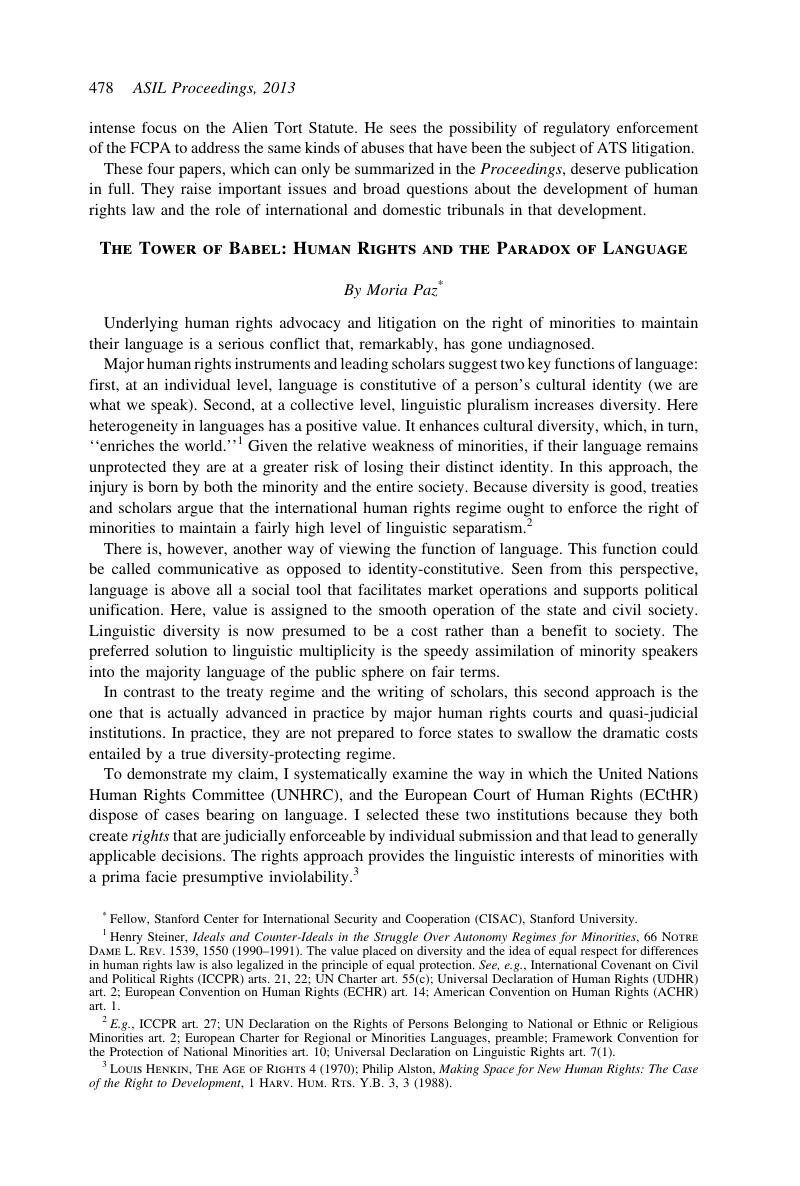No CrossRef data available.
Article contents
The Tower of Babel: Human Rights and the Paradox of Language
Published online by Cambridge University Press: 20 January 2017
Abstract

- Type
- New Voices: Human Rights
- Information
- Copyright
- Copyright © American Society of International Law 2014
References
1 Steiner, Henry, Ideals and Counter-Ideals in the Struggle Over Autonomy Regimes for Minorities, 66 Notre Dame L. Rev. 1539, 1550 (1990–1991)Google Scholar. The value placed on diversity and the idea of equal respect for differences in human rights law is also legalized in the principle of equal protection. See, e.g., International Covenant on Civil and Political Rights (ICCPR) arts. 21, 22; UN Charter art. 55(c); Universal Declaration of Human Rights (UDHR) art. 2; European Convention on Human Rights (ECHR) art. 14; American Convention on Human Rights (ACHR) art. 1.
2 E.g., ICCPR art. 27; UN Declaration on the Rights of Persons Belonging to National or Ethnic or Religious Minorities art. 2; European Charter for Regional or Minorities Languages, preamble; Framework Convention for the Protection of National Minorities art. 10; Universal Declaration on Linguistic Rights art. 7(1).
3 Henkin, Louis, The Age of Rights 4 (1970)Google Scholar; Alston, Philip, Making Space for New Human Rights: The Case of the Right to Development, 1 Harv. Hum. Rts. Y.B. 3, 3 (1988)Google Scholar.
4 UNHRC, General Comment 23, 1994.
5 Sohn, Louis B., The Rights of Minorities, in The International Bill of Rights—The Covenant of Civil and Political Rights 285 (Henkin, Louis ed., 1981)Google Scholar; Thornberry, Patrick, International Law and the Rights of Minorities 197 (1991)Google Scholar; Henkin, Louis, Introduction, in The International Bill of Rights—The Covenant of Civil and Political Rights 21 (Henkin, Louis ed., 1981)Google Scholar.
6 E.g., Thlimmenos v. Greece (2000); Stec v. UK (2006); D.H. v. Czech Republic (2007).
7 E.g., de Witte, Bruno, Language Rights: The Interaction Between Domestic and European Developments, in Linguistic Diversity and European Democracy 172 (Kjaer, Anne Lise & Adamo, Silvia eds., 2011)Google Scholar.
8 For examples of how these narrow categories of protection emerge in case law, see Paz, Moria, The Failed Promise of Language Rights: A Critique of the International Language Rights Regime, 54 Harv. Int’l L J. (2013)Google Scholar; Moria Paz, The Tower of Babel: Human Rights and the Paradox of Language (forthcoming).




